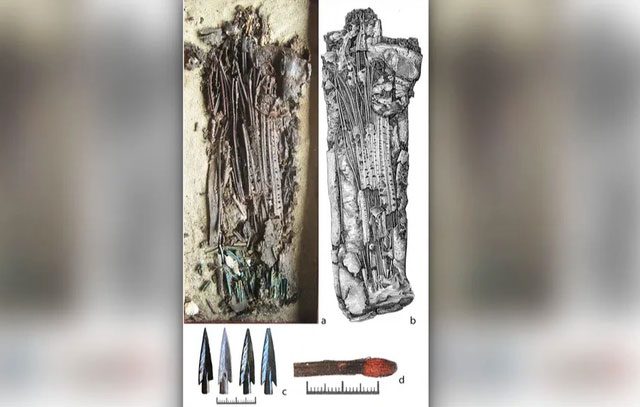Ancient 2,400-Year-Old Tombs of the Scythians – Fierce and Terrifying Nomadic Warriors.
According to a paper published in the scientific journal PLOS One, researchers analyzed 45 processed skin samples from 18 ancient tombs excavated from 14 sites in Southern Ukraine.
The skin samples were all taken from burial artifacts. Dated at 2,400 years old, the items in these tombs are considered “treasures” of great value. However, this time, scientists were unsettled by two of these “treasures.”
Two samples of skin, coming from a quiver and a container for arrowheads, turned out to be human skin!

A quiver belonging to the Scythians excavated from an ancient tomb – (Photo: PLOS One).
The findings confirmed the chilling claims of the ancient Greek historian Herodotus (who lived in the 5th century BC) that the Scythians used human skin to create their tools.
“These items are a crucial aspect of Scythian warrior identity, and it’s likely that these quivers were buried with their owners,” said Associate Professor Margarita Gleba, an archaeologist from the University of Padua (Italy) and co-author of the study, in an interview with Live Science.
The research team analyzed the skin by examining the proteins in the organic material, which helped determine the species of the animal involved.
In addition to the two samples made from human skin, 43 other samples were made from the skins of animals, including sheep, goats, horses, and other livestock.
Archaeological evidence does not clearly reveal why human skin was used to craft these items, but according to the renowned historian Herodotus, these fearsome “head-hunting” warriors would often skin their victims with a cow’s rib.
The Greek historian also noted that the warriors would tie pieces of skin to their reins as “trophies,” symbolizing a man’s strength. Portions of skin and right-hand nails were also used to cover the arrow containers.
The Scythians Thrived from Around 800 BC to 300 AD, with the period when these ancient burial mounds were built—about 2,400 years ago—marking their golden age. Besides instilling fear as powerful and aggressive warriors, they were also famous for a complex civilization with advanced technologies compared to contemporary tribes. They were also known for their exquisite gold mining and craftsmanship, as well as their significant advancements in pastoralism. |




















































